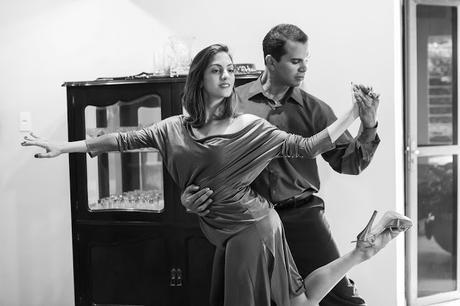~ * ~
There’s a lot to think about during ballroom dance lessons. You are learning a lot of skills in a short period of time. If you are new to dance, it can get overwhelming. What should you be focusing on? What’s more important, the music, the steps, the holds, or the positions? Whether you are a beginner or an experienced dancer, one of the most important things to focus on is positioning your body correctly as you move and that begins with your knees and hips.When we’re learning a new dance, most dancers are tempted to look at their feet or at our partner’s feet, but it’s more important to focus on your knees and hips. They are key to some of the most important aspects of dance including posture, balance, timing, motion, endurance, and joint health. Proper knee and hip movement also helps you create a solid foundation so you can learn more advanced moves quickly and easily.PosturePosture is key to ballroom dancing, and good body mechanics results in good dancing. Dance positions and holds change from dance to dance but they all have one thing in common: Posture. Your spine, hips, legs and knees need to be properly aligned while you move. For beginners, this may seem like a lot to think about, but the knees and hips are where it all starts. Focusing on them will also help you position your torso, pelvis, ankles, and feet properly.

BalanceBad knee and hip movement can also really throw off your balance. When you bend forward at the knees, your hips and feet need to stay in line with each other. To maintain your balance, you’ll need to lengthen your torso at the same time. Otherwise, your pelvis may tuck under or stick out backward, which will throw you off-balance. Never lock your knees; slightly flexed knees also allow for quicker movements. This is especially important in Swing dancing when the moves require you to reverse directions quickly.TimingIn many dances, knee and hip movement is key to good timing. Focusing on your knees and hips ensures that you are timing your movements with the correct beat. This is especially important in Latin dances, where the hip motion is a result of alternating between bending and straightening the knees. For beginners, this might be a little tricky at first as it requires isolating the spine from the hips instead of swaying your whole body. But, if your knee action is proper, good isolation of the hips comes naturally.For instance, when dancing the Samba the whole beat and half beat mark the point at which body changes direction. The characteristic Samba Bounce is achieved by a slight flexing of the knees coupled with a forward pelvic pendulum movement on the first half of the beat. On the second half of the beat, the knees are straightened slightly and the pelvic pendulum moves back. The knees motivate the hip motion.
Motion
When most people think of knee and hip movement, they think of the Latin dances. But proper knee and hip motion is important to all styles of dance. When you are moving in time and have proper balance and posture, dancing with a partner is much easier and it will feel smooth and natural.Your hips and knees are central to your motion. As you move on the dance floor, your knees and hips need to absorb the shock, or your dancing will seem choppy or mechanical. Whether you are leading or following, fluid motion keeps the look and feel of the dance effortless.EnduranceDance is requires a lot of activity and tons of practice. Proper posture and movement let you move your body more efficiently. If you aren’t moving your knees and hips correctly, you will waste a lot of effort and tire faster. Poor body position also causes tension in other parts of the body which can sap your energy or cause you pain, making it difficult to dance as much as you need to. Focusing on the knees and hips will help ensure your posture is proper so you’ll have the energy to dance the whole night away.Joint healthDancing is a fun way to get some exercise, but it can also be very demanding. Proper posture keeps all your joints healthy and prevents injury. If you aren’t properly moving your hips and knees, you can suffer from repetitive motion injuries such as tendonitis or bursitis, which are painful and often require rest and rehab. Improper movement also makes you more susceptible to sprains and strains, which can take you off the dance floor for weeks or months. Moreover, tension in your lower body travels and can cause tension in your back, shoulders and neck.Foundations
Learning to dance is like learning any new motor skill: it requires practice and repetition until it becomes automatic. When you are taking ballroom dance lessons, it’s important to learn the moves right the first time so you have a strong foundation to build on. Pay attention to the position of your body as you move to ensure you haven’t picked up any bad habits. If you do, more advanced moves will be difficult, awkward or impossible, which will slow you down later on.When you are just beginning, you are building muscle memory. If you train your muscles right the first time, many things will come more naturally. If you train yourself to move incorrectly, you will have to unlearn and relearn moves, which is a difficult process. There is a lot to focus on during your dance lessons. Whether you are a beginner or an experienced dancer, don’t stare at your toes. Instead, pay attention to your knees and hips. They are key to building a solid foundation and maintaining good posture. They are also central to balance, timing, motion, endurance and joint health. If you master proper knee and hip movement, you’ll be able to learn more advanced moves quickly and easily and your whole body will be healthier.